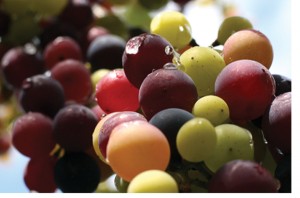Better With Age
 When head winemaker Cory Bomgaars of Les Bourgeois Vineyards in Rocheport samples berries to be used in wine production, he spends the morning tossing up to 300 grapes in his mouth. With a dozen or so of those berries, Bomgaars pops the pulp with his teeth and then carefully examines the remnants in his hand for ripeness, proper hydration and, of course, flavor.
When head winemaker Cory Bomgaars of Les Bourgeois Vineyards in Rocheport samples berries to be used in wine production, he spends the morning tossing up to 300 grapes in his mouth. With a dozen or so of those berries, Bomgaars pops the pulp with his teeth and then carefully examines the remnants in his hand for ripeness, proper hydration and, of course, flavor.
“You can pull off the stem at the top of the grape, and if the skin that gets torn away is green, the grape is less ripe,” Bomgaars says.
But aside from each berry’s characteristics, the spacing between vines, pruning and their exposure to the sun help determine the eventual quality of the wine, he says.
Thirty acres of vineyards are inspected on the Les Bourgeois property, up from five in 1997. This growth in property is accompanied by a growth in business.
“Les Bourgeois sold 40,000 gallons of wine in 1995,” Bomgaars says. “We’re looking to sell 130,000 this year.”
The recent $3.5 million investment in the construction of a 14,000-square-foot winemaking facility just outside Columbia has greatly enhanced efficiency.
“In four to five hours of one day, we processed 20 to 40 tons of grapes,” says Tim Weiss, director of sales for Les Bourgeois.
Decreased work hours spent making the wine leaves more time to examine technique. Bomgaars estimates the new facility saves 60 hours a week in labor, hours that are transferred into concentrating on the vineyards and how to best yield a higher-quality crop.
“We’re not working less,” Bomgaars says. “We’re taking less winemaking labor and working more on tweaking our processing techniques. We’re spending more time trying to figure out what’s going to take us to the next level of quality.”
The importance o f quality becomes more significant as Les Bourgeois’ wholesale business expands. Although 20 percent of Les Bourgeois’ sales occur on company property, Bomgaars says 70 percent of Les Bourgeois’ wine is sold on the wholesale market.
f quality becomes more significant as Les Bourgeois’ wholesale business expands. Although 20 percent of Les Bourgeois’ sales occur on company property, Bomgaars says 70 percent of Les Bourgeois’ wine is sold on the wholesale market.
“That requires a big change in our approach to business,” he says. “It’s one thing to drink (Les Bourgeois) wine at a winery with a pretty view. It’s another thing to choose a bottle of (Les Bourgeois) out of thousands of other options at a grocery store.”
Weiss says Les Bourgeois has experienced steady wholesale growth during the past three to four years, despite economic woes. This consistent expansion can be partly attributed to the seemingly downtrodden economic climate, he says. When the restaurant industry takes a hit — such as during the recent recession — wholesale gets a boost.
“People are cooking at home and aren’t going out to eat; they aren’t going out to restaurants to drink their wine and liquor,” Weiss says.
And when consumers buy at the grocery store, he says, they buy local, and they buy more inexpensively; the $25-a-bottle wine drinkers trade down to $15 a bottle, and those who initially preferred wines that cost $15 a bottle trade down to wines that cost $7 a bottle.
“That’s the market Les Bourgeois plays in,” Weiss says. “Then people realize they can get good wine locally and at an inexpensive price.”
Bomgaars says consumers have been searching more for local products of quality, and Missouri has proved it can produce quality wine. As Les Bourgeois expands into Illinois, Louisiana and Kansas, the wine industry in Missouri continues to expand as a whole.
According to the report titled “The Economic Impact of Wine and Grapes in Missouri 2010,” there were 97 operating wineries in 2009, up from 50 in 2005. In 2010, Missouri’s wine industry collected $1.2 billion in revenue, paid close to $4 million in wages and had a total economic impact of nearly $1.6 billion. With such expansion in the industry comes stiffer competition — a consequence that Bomgaars views positively.
“As competition he ightens, so does the incentive for higher quality,” he says. “The competition is in our own backyard.”
ightens, so does the incentive for higher quality,” he says. “The competition is in our own backyard.”


